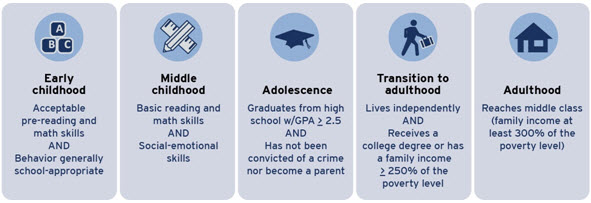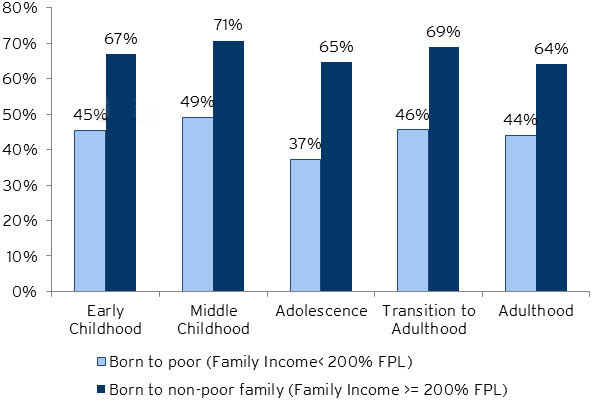Last week, the House Budget Committee, chaired by Rep. Paul Ryan (R-Wisc.) released “Expanding Opportunity in America,” (pdf) a detailed agenda to increase economic opportunity and mobility in America. The paper notes that while rates of absolute upward mobility “are no lower or higher today than in the 1970s and perhaps even the 1950s,” the phenomenon of relative upward mobility “has been lackluster.”” According to the paper:
A key tenet of the American Dream is that where you start off shouldn’t determine where you end up. If you work hard and play by the rules, you should get ahead. But the fact is, far too many people are stuck on the lower rungs.
The paper cites a wide range of academic and policy literature across a diversity of organizations, including many ideas that have been long-discussed by Brookings Institution scholars. Below are highlights of where Brookings scholarship found its way into the report.
Family and Behavior Matter
“In addition, the Brookings Institution has shown that a combination of family conditions and patterns of behavior and achievement is the key to joining to the middle class.”
The paper cites research by Isabel Sawhill, co-director of the Center on Children and Families, and Kimberly Howard on how one’s conditions and choices at successive stages of life affect the chances of climbing the mobility ladder into the middle class by adulthood. The “best way to guide individuals toward adult success,” they argue, “is to encourage their continued success by intervening multiple times, as needed.”
Meeting Developmental Milestones Improves Children’s Life Chances
“And so opportunity begins to fade for low-income students before they even enter school. Though understanding what exactly should be done requires more research, there are some important developmental milestones that, when met, show promise and when missed are a lost opportunity. Kerry Searle Grannis and Isabel Sawhill find that 67 percent of students in higher-income families meet the academic and behavioral standards in early childhood described in Figure 8. But only 45 percent of students in lower-income families do … But the federal government can do a better job. Kerry Searle Grannis and Isabel Sawhill argue that direct aid at key moments in children’s lives can help close the achievement gap.”
Sawhill and her colleagues in CCF, including Kerry Searle Grannis, developed the Social Genome Model, a framework for measuring children’s life chances based on their experiences from birth through middle age. This work, including the following charts, were referenced in the committee report.
Finish High School
“States should also make a special effort to encourage low-income students to finish high school. Although national high-school graduation rates have never been higher, students from low-income families are still dropping out at a higher rate than their peers. Consequently, they are less likely to work or get married—and more likely to make less money.”
The committee’s report cites research on helping high school dropouts by CCF’s Haskins and Dan Bloom of MDRC. “Lowering the number of adolescents who fail to finish high school and helping those who drop out get back on track must be a major policy goal for our nation,” Haskins and Bloom argue. “Americans who do not graduate from high school,” they write, “pay a heavy price personally. Although correlation is not causation, the links between leaving school before graduating and having poor life outcomes are striking. Perhaps the most important correlation is that between dropping out and low income.” Continuing, they say:
Dropping out of school is also linked with many other negative outcomes such as increased chances of unemployment or completely dropping out of the workforce, lower rates of marriage, increased incidence of divorce and births outside marriage, increased involvement with the welfare and legal systems, and even poor health. All these outcomes are costly not only to dropouts personally, but also to society.
Improve College Prep to Help More Students Attend College
“Building off the work of Ron Haskins, Harry Holzer, and Robert Lerman, one way to reform these programs would be to collapse them into a single grant program, allowing schools to use ‘any of the college preparation approaches now allowed by the separate programs but would base funding decisions on performance’ outcomes such as enrollment, graduation rates, and use of best practices such as data collection and rigorous analysis.”
In a report for the Economic Mobility Project on post-secondary education (pdf), Haskins with the Urban Institute’s Holzer and Lerman write that:
The powerful impact postsecondary education has on the economic mobility of both individuals and their children is clear. Education, postsecondary education in particular, is one of the most effective tools our nation has for promoting upward mobility. However, we may not have achieved equal opportunity in this regard. Only one-third of children from families in the bottom income quintile enroll in college, and of those, only a portion graduate. At a time when economic returns to education have never been higher, it is important that we focus our attention on boosting college enrollment and completion, particularly for the most disadvantaged children.
The authors provide an overview of college preparation programs and, “Because of the strong evidence that poor, low-income and minority students are, on average, not well-prepared for college, we propose several measures that may increase their ability to succeed in postsecondary institutions.”
Student Loan “Forgiveness” Not Best Solution
“New proposals to forgive more student loans would make things worse. They would do nothing to lower costs and everything to encourage reckless borrowing: If students know that all their debt will eventually be forgiven, they have no reason to shop for the best deal.”
Fellows Beth Akers and Matt Chingos of the Brown Center on Education Policy at Brookings have been examining the issue of student loan debt and have commented on various proposals to alleviate what some have called a crisis. Akers and Chingos write that the “sensational media coverage about college graduates suffering under mountains of debt often ignores a crucial fact: safety nets already exist for many borrowers facing unaffordable monthly payments.”
In their recent paper on the income-based repayment program—”the primary safety net available to borrowers of federal loans facing unaffordable monthly payments”—Akers and Chingos find that “existing programs may be as much as four times more costly than they need to be to accomplish their core mission of protecting borrowers from unaffordable monthly payments.”
Address Cost Burden on Society of Correctional Spending
“About 2.2 million people are currently behind bars—a more than 340 percent increase since 1980. As a result, we spend about $80 billion on corrections at all levels of government—an inflation-adjusted increase of over 350 percent in that same period. This growing cost burden on society is a cause for concern. But perhaps what’s most troubling is the effect on individuals and families.”
The Hamilton Project at Brookings recently detailed ten economic facts related to recent trends in crime and incarceration in the United States, finding, among other things, that while crime rates “have been on a steady decline since the 1990s,” the “incarceration rate in the United States is now at a historically unprecedented level and is far above the typical rate in other developed countries.” This trend is costly to taxpayers, state governments, and those imprisoned and their families.
Simplify EITC Filing
“… another potential area of reform should focus upon EITC simplicity and delivery. If families received the credit with their paychecks, the link between work and the EITC would be that much clearer. This reform would also allow low-income to keep more of their money if it could reduce improper payments (which amounted to $13.3 billion in fiscal year 2013 alone); they wouldn’t have to rely on tax-preparation firms to get the credit.”
In 2002, Alan Berube, a senior fellow in the Metropolitan Policy Program at Brookings, along with Anne Kim, Benjamin Forman, and Megan Burns, detailed how many EITC-eligible taxpayers often rely on costly tax preparation services that can divert benefits from recipients. “Our research,” they wrote,
finds that high-cost tax preparation services and products can significantly diminish the economic benefits of the EITC—both for low-income working families and for the neighborhoods in which they live. Federal, state and local officials should therefore take steps to ensure that tax preparation and expensive refund loans do not erode government’s efforts to support work through the EITC.
The report also cited a 2007 Hamilton Project paper by John Karl Scholz on employment-based tax credits for low-skilled workers.
The Ryan report also credited the work of Stuart Butler, a leading scholar on poverty currently at the Heritage Foundation who is joining Brookings as a senior fellow in September, on the question of whether government can “replicate success,” and on reforming the higher education accreditation process.
Elina Saxena contributed to this post.
The Brookings Institution is committed to quality, independence, and impact.
We are supported by a diverse array of funders. In line with our values and policies, each Brookings publication represents the sole views of its author(s).






Commentary
The Brookings Ideas that Made It into Paul Ryan’s Expanding Opportunity Proposal
July 30, 2014